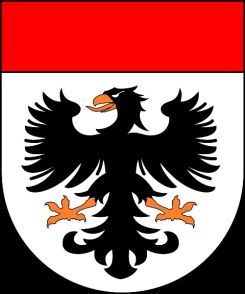Difference between revisions of "Aarau"
Tao alexis (talk | contribs) |
Tao alexis (talk | contribs) |
||
| (3 intermediate revisions by the same user not shown) | |||
| Line 1: | Line 1: | ||
[[File:Aarau Coat of Arms.jpg|right|245px|thumb|Aarau Coat of Arms]] | [[File:Aarau Coat of Arms.jpg|right|245px|thumb|Aarau Coat of Arms]] | ||
| − | '''Aarau''' is a town in the Principality of [[Berne (principality)|Berne]], situated on the Aar River, in the Aar Valley at the foot of the Jura Mountains, 41 mi. northeast of Berne. Aarau has a large cantonal library with rare | + | '''Aarau''' is a town in the Principality of [[Berne (principality)|Berne]], situated on the Aar River, in the Aar Valley at the foot of the Jura Mountains, 41 mi. northeast of Berne. Aarau has a large cantonal library with rare manuscripts and incunabula (books printed using metal type before the year 1500). An ancient tower, the Rathaus, and other quaint buildings give it a picturesque aspect. |
Goods produced in and around Aarau include iron<sup><small>2R</small></sup>, salt, cotton and silk cloth, cement, bells<sup><small>2R</small></sup>, precision tools and knives. Population (c.1650), 1,353. | Goods produced in and around Aarau include iron<sup><small>2R</small></sup>, salt, cotton and silk cloth, cement, bells<sup><small>2R</small></sup>, precision tools and knives. Population (c.1650), 1,353. | ||
| − | === Aargau Barony === | + | ====== Aargau Barony ====== |
Surrounding the town of Aarau is the '''Barony of Aargau''', extending from the core of the Aar Valley to the north across the Jura Mountains, to the Rhine River, and to the south over the adjacent Swiss Plateau. The area is 542 sq.m. It's population is concentrated in the Aar Valley, its side branches and along the Rhine, and is mainly concerned with fruit-growing. The Barony became subject to Berne in 1415. Pop., 4,547. | Surrounding the town of Aarau is the '''Barony of Aargau''', extending from the core of the Aar Valley to the north across the Jura Mountains, to the Rhine River, and to the south over the adjacent Swiss Plateau. The area is 542 sq.m. It's population is concentrated in the Aar Valley, its side branches and along the Rhine, and is mainly concerned with fruit-growing. The Barony became subject to Berne in 1415. Pop., 4,547. | ||
The Barony includes the ruins of Habsburg Castle, destroyed during the Thirty Years' War, along with the town of the same name, which was not rebuilt prior to 1650. The castle was originally built about 1020; the town was granted municipal rights by Rudolph of Habsburg, and was seized from the Habsburg family along with the rest of the Barony. | The Barony includes the ruins of Habsburg Castle, destroyed during the Thirty Years' War, along with the town of the same name, which was not rebuilt prior to 1650. The castle was originally built about 1020; the town was granted municipal rights by Rudolph of Habsburg, and was seized from the Habsburg family along with the rest of the Barony. | ||
| + | |||
| + | [[Category: Places in Switzerland]] | ||
Latest revision as of 01:48, 10 May 2023
Aarau is a town in the Principality of Berne, situated on the Aar River, in the Aar Valley at the foot of the Jura Mountains, 41 mi. northeast of Berne. Aarau has a large cantonal library with rare manuscripts and incunabula (books printed using metal type before the year 1500). An ancient tower, the Rathaus, and other quaint buildings give it a picturesque aspect.
Goods produced in and around Aarau include iron2R, salt, cotton and silk cloth, cement, bells2R, precision tools and knives. Population (c.1650), 1,353.
Aargau Barony
Surrounding the town of Aarau is the Barony of Aargau, extending from the core of the Aar Valley to the north across the Jura Mountains, to the Rhine River, and to the south over the adjacent Swiss Plateau. The area is 542 sq.m. It's population is concentrated in the Aar Valley, its side branches and along the Rhine, and is mainly concerned with fruit-growing. The Barony became subject to Berne in 1415. Pop., 4,547.
The Barony includes the ruins of Habsburg Castle, destroyed during the Thirty Years' War, along with the town of the same name, which was not rebuilt prior to 1650. The castle was originally built about 1020; the town was granted municipal rights by Rudolph of Habsburg, and was seized from the Habsburg family along with the rest of the Barony.
